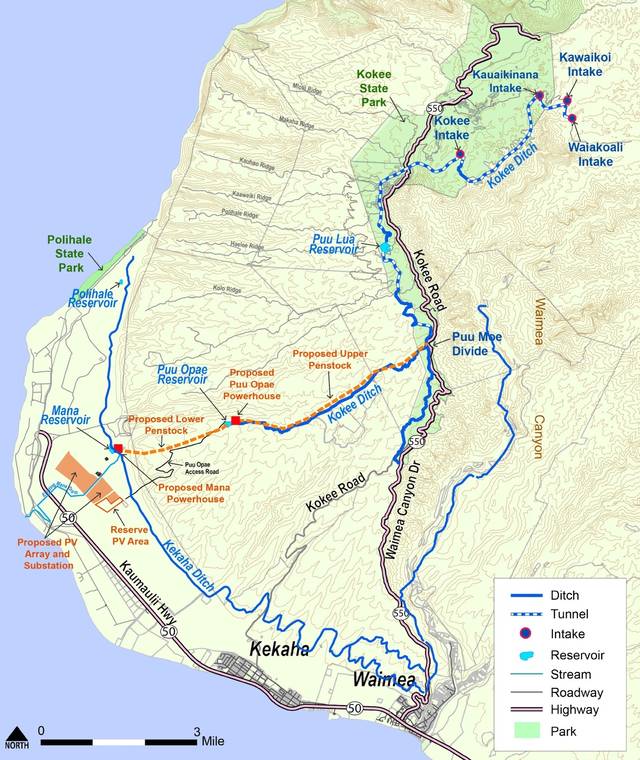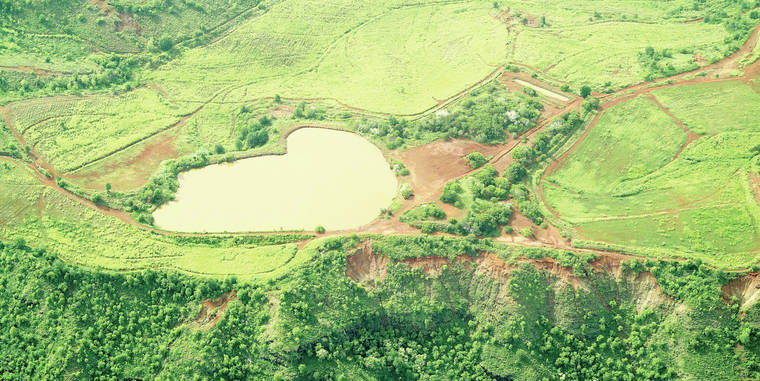LIHU‘E — Kaua‘i Island Utility Cooperative has partnered with AES Corporation to build an innovative solar photovoltaic, battery energy storage and pumped storage hydro project, which will be the first of its kind in the world.
KIUC recently shared their West Kaua‘i Energy Project presentation virtually with Lihu‘e Business Association members.
KIUC is expected to start construction in late 2022 or early 2023, and to have it complete and operational no later than 2025, according to Beth Tokioka, communications manager of KIUC.
According to Tokioka, WKEP involves the use of three state-owned reservoirs from Koke‘e to Mana. Water from streams in Koke‘e will be delivered to Pu‘u Lua Reservoir in Koke‘e, to be stored and released via a ditch system and approximately 4.5 miles of buried pipeline to a powerhouse at Pu‘u ‘Opae Reservoir.
Then a 4-megawatt hydroelectric generator at Pu‘u ‘Opae will provide flow-through power generation, as the water then continues downhill through more pipelines to Mana Reservoir, where a 20-megawatt hydropower turbine will produce the bulk of the project’s electricity.
Adjacent to the Mana Reservoir, a 35 megawatt solar and battery storage system will generate the power to pump water from Mana back up to Pu‘u ‘Opae during the day. At night, the process repeats.
Pu‘u ‘Opae essentially acts as a battery: getting filled — or charged — each day, so the stored energy can be used overnight or across a period of days in times of emergency or extended periods with no sunlight.
The storage capacities of the three reservoirs are Mana at 80 million gallons, Pu‘u Opae with 100 million gallons, and Pu‘u Lua with 200 million gallons.
“Of the three reservoirs, only one is currently holding water: Pu‘u Lua. Even that reservoir is only holding roughly one-third of its capacity,” Tokioka said. “The other two are essentially dry.”
In the future, KIUC members can expect to save between $157 and $172 million versus the projected cost of diesel over the 25-year term of the purchase-power agreement, according to Tokioka.
Currently, KIUC serves 37,000 electric accounts, 29,000 of which are residential member-owners, and 3,000 are commercial member-owners.
To help keep costs down, Tokioka said KIUC will purchase solar power from AES at a fixed price of 71 cents per kilowatt-hour, which is at least 30% lower than any of KIUC’s currently-operating, utility-scale solar facilities.
In addition, Tokioka said AES will be paid $8.9 million per year via a hydropower capacity charge for maintaining 24 megawatts of firm renewable capacity, along with 240-megawatt hours of long-duration storage daily.
“In times of emergency, more than 1,300-megawatt hours of storage offered by Pu‘u Lua Reservoir can also be used,” Tokioka said. “The average annual cost for the operation of WKEP would be $15 cents per kilowatt-hour, which is comparable to what we pay for other renewable sources but with all the other benefits of the project, include irrigation for agriculture, fire-suppression capabilities, (and) compliance with the IFS for the streams in Koke‘e and Waimea River.
“Bringing on AES as the developer will deliver millions of dollars in savings via federal and state solar tax credits which are not available to KIUC as a nonprofit entity,” Tokioka said.
Tokioka said the environmental benefits of the project are huge: It’ll reduce fossil-fuel usage by more than 8 million gallons per year, with an estimated annual reduction of about 80,000 tons of CO2 emissions.
“This project on the Westside has really ended up as the No. 1 project out there, the best potential,” KIUC President and CEO David Bissell said. “I think it’s really good for the island.”
According to Bissell, Kaua‘i’s renewable options are limited to solar and hydro, and WKEP will push KIUC above 80% of electrical production via renewable energy.
Bissell said WKEP will meet up to 25% of KIUC’s energy needs, and will have long-duration storage capabilities.
And KIUC runs on 100% renewable from 9 a.m. to 5 p.m. daily.
Meanwhile, they have added new projects over the years.
“We added some very substantial storage projects,” Bissell said.
“The Tesla project here in Lihu‘e, the AES Lawa‘i project, and soon the AES PMRF project.”
KIUC’s first step is the solar and pumped storage hydro’s primary project components, which include repairs and upgrades on Koke‘e’s diversion and ditch system, and rehabilitation of Pu’u Lua, Pu‘u ‘Opae and Mana reservoirs.
The WKEP will also construct two new sections of buried pipeline and two new powerhouses/substations while adding new solar and battery facilities.
There will also be support for agriculture and food sustainability on the Westside. WKEP will enable the state Department of Hawaiian Home Lands to utilize Pu‘u ‘Opae mauka lands for agriculture and homesteads.
“Going down into DHHL land, it’s really exciting,” Bissell said.
“They’re around the Pu‘u ‘Opae Reservoir. With that water — the irrigation running down there.”
Bissell said a lot of road infrastructures will be put in place to help the Native Hawaiian community on the Westside.
“I believe 200 lots or more are planned to be opened,” Bissell said. “Because they will have irrigation because of this project, it will improve the roads. Not going to be great but passable by four-wheel drive vehicles, and we will also have electrical service up there because we will have the power plants.”
This project is a huge undertaking, which is why KIUC has partnered with AES, a trusted partner of KIUC which has had a presence in Hawai‘i for more than 25 years. By partnering with AES, the financial risk shifts from the cooperative to a development partner.
According to KIUC, AES can take advantage of federal and state credits, lowering the cost of the project, which translates into rate savings for KIUC members.
Lastly, Bissell said environmental compliance is in progress. KIUC has started studies conducted on stream and habitat assessments.
KIUC said members of the public are encouraged to participate in an informational virtual community meeting to learn about WKEP.
The meeting will be held on Wednesday, March 31, starting at 6 p.m. via Zoom. Attendees can register to participate at westkauaienergyproject.com.
•••
Stephanie Shinno, education, business, and community reporter can be reached at 245-0424 or sshinno@thegardenisland.com.







Please clarify, the story first states that KIUC will pay a fixed rate of $0.71 per KWH, then later states the average cost will be $0.15 per KWH. Which is it? $0.15 is not awful, by $0.71 is insanely expensive.
Thanks
Good question. FYI, the cost of solar for the project is .071 per kwh, not .71.
Good question. The cost of the solar component is actually .071 per kwh. The .15 per kwh includes the solar component along with the capacity charge for the hydro component. So all in, the project will come in at .15 per kwh, which includes the cost of all the benefits of infrastructure/reservoir maintenance, delivery of irrigation water, maintenance of the stream diversions, etc.
they never show the long-term cost of these projects…. how do they know what diesel will cost 10 or 20 years from now? Who is doing those forecasts;
what are the long-term repair costs, to maintaining the facility and replacing one our batteries?
where do we dispose of the worn out batteries and what are the environmental impacts?
they always paint a rosy picture, with smoke and mirrors on the front end…. remember, the large print giveth, and the small print taketh away…..
The costs you mention here are all included in the contract with AES. For the solar field it’s a 20 year contract and for the hydro portion it’s 50 years. So the cost is fixed to KIUC and the risk is borne by AES. This is one of the benefits of having a 3rd party developer – especially one with vast experience and resources such as AES. The risk is pushed to AES.
How will this affect the state park and all it has to offer? Will this affect the trout fishing? I hope part of this plan enables a fleet of electric rental cars? Or how about more charging stations. Make this unique power system work for Kaua’i.
One of the requirements on KIUC will be to insure that flow in Kokee streams from which water will be diverted is maintained at state-mandated levels. Puu Lua Reservoir will be rehabilitated – it’s currently filled to only 30% capacity – and the access roads will be improved. So it’ll be a better fishing experience once the project is completed.
This is one of the best ideas that they’ve come across utilizing industrial engineering and new technology to produce clean energy.
The system was talked about for years and it became a hot topic during the KauaiEclectic blogs.
Finally KIUC has hired some people with Brian’s instead of the old plantation families.
Now they have to hire people who can maintain the system instead of some family friends or their own undereducated kids.
These will be good paying jobs and it’s slated to produce over 200,000 new jobs in the US.
The only problem is KIUC’s greedy profit margins.
No more free rice bags bribes.
KIUC is a non-profit cooperative. We don’t make profits. Any earnings in excess of expenses is returned to members annually either into their patronage capital accounts or as a patronage capital retirement in the form of a check or bill credit.
According to this map, there is a trail at Koke’e state park that leads you all the way into seeing the Kalalau lookout or Kalapaki Beach. Of which can also be hiked from Anahola, east Kaua’i or North Kaua’i. I think you can do it either way.
If I can remember this correctly. I know where this is looking from the Map. It looks like I’ve been here before. Or at least close to it.